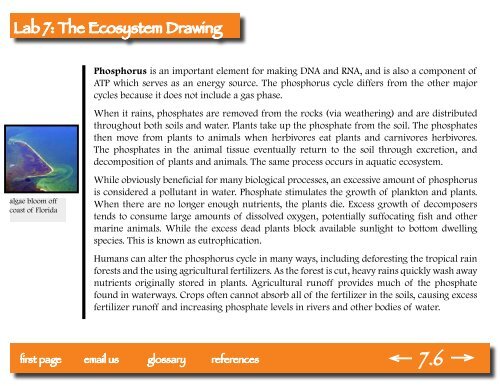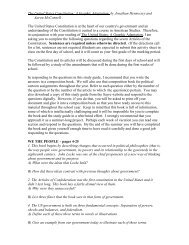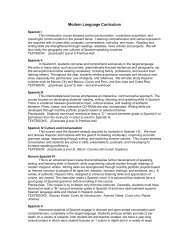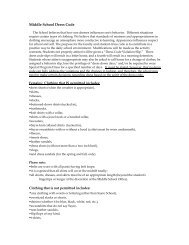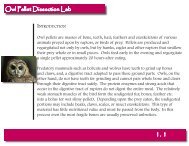Lab 7 Identifying Limiting Nutrient - Sayre School
Lab 7 Identifying Limiting Nutrient - Sayre School
Lab 7 Identifying Limiting Nutrient - Sayre School
Create successful ePaper yourself
Turn your PDF publications into a flip-book with our unique Google optimized e-Paper software.
<strong>Lab</strong> 7: The Ecosystem Drawing<br />
Phosphorus is an important element for making DNA and RNA, and is also a component of<br />
ATP which serves as an energy source. The phosphorus cycle differs from the other major<br />
cycles because it does not include a gas phase.<br />
When it rains, phosphates are removed from the rocks (via weathering) and are distributed<br />
throughout both soils and water. Plants take up the phosphate from the soil. The phosphates<br />
then move from plants to animals when herbivores eat plants and carnivores herbivores.<br />
The phosphates in the animal tissue eventually return to the soil through excretion, and<br />
decomposition of plants and animals. The same process occurs in aquatic ecosystem.<br />
algae bloom off<br />
coast of Florida<br />
While obviously beneficial for many biological processes, an excessive amount of phosphorus<br />
is considered a pollutant in water. Phosphate stimulates the growth of plankton and plants.<br />
When there are no longer enough nutrients, the plants die. Excess growth of decomposers<br />
tends to consume large amounts of dissolved oxygen, potentially suffocating fish and other<br />
marine animals. While the excess dead plants block available sunlight to bottom dwelling<br />
species. This is known as eutrophication.<br />
Humans can alter the phosphorus cycle in many ways, including deforesting the tropical rain<br />
forests and the using agricultural fertilizers. As the forest is cut, heavy rains quickly wash away<br />
nutrients originally stored in plants. Agricultural runoff provides much of the phosphate<br />
found in waterways. Crops often cannot absorb all of the fertilizer in the soils, causing excess<br />
fertilizer runoff and increasing phosphate levels in rivers and other bodies of water.<br />
email us<br />
glossary 7.6


